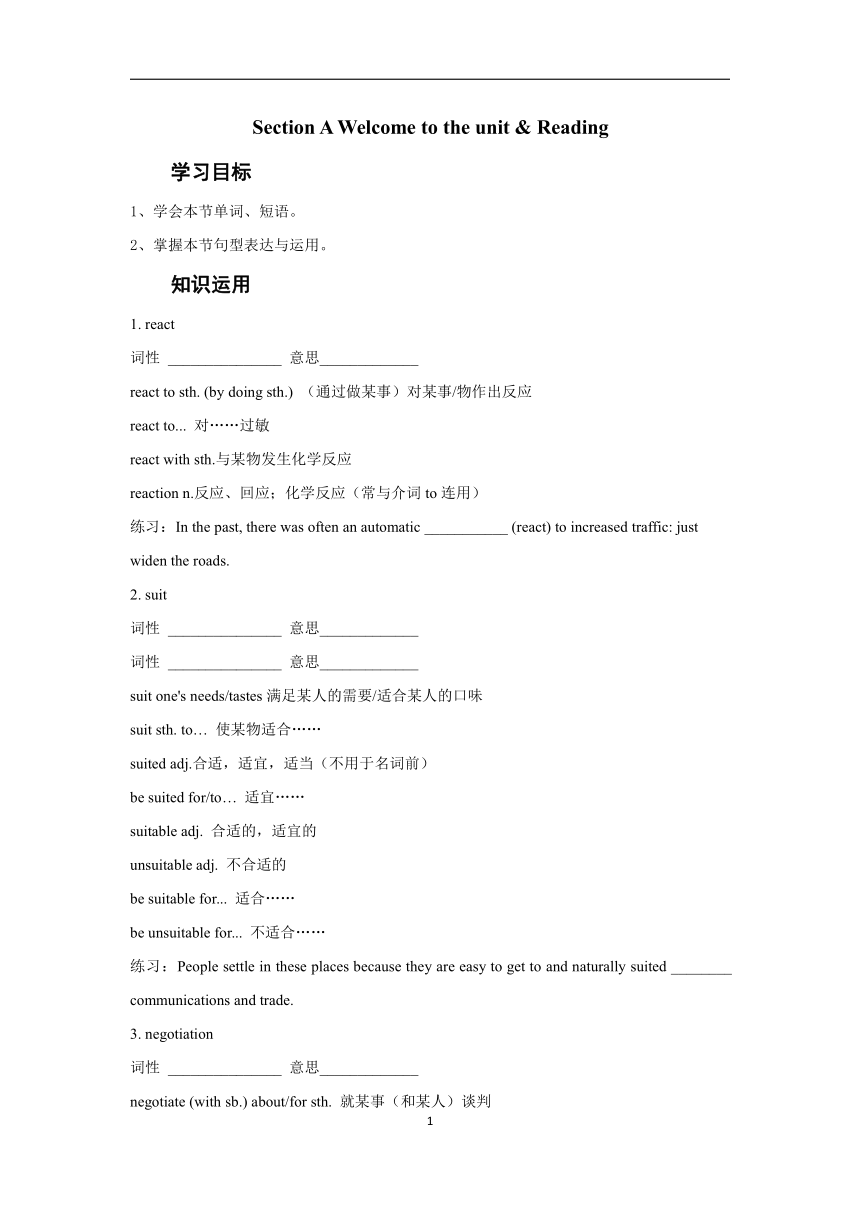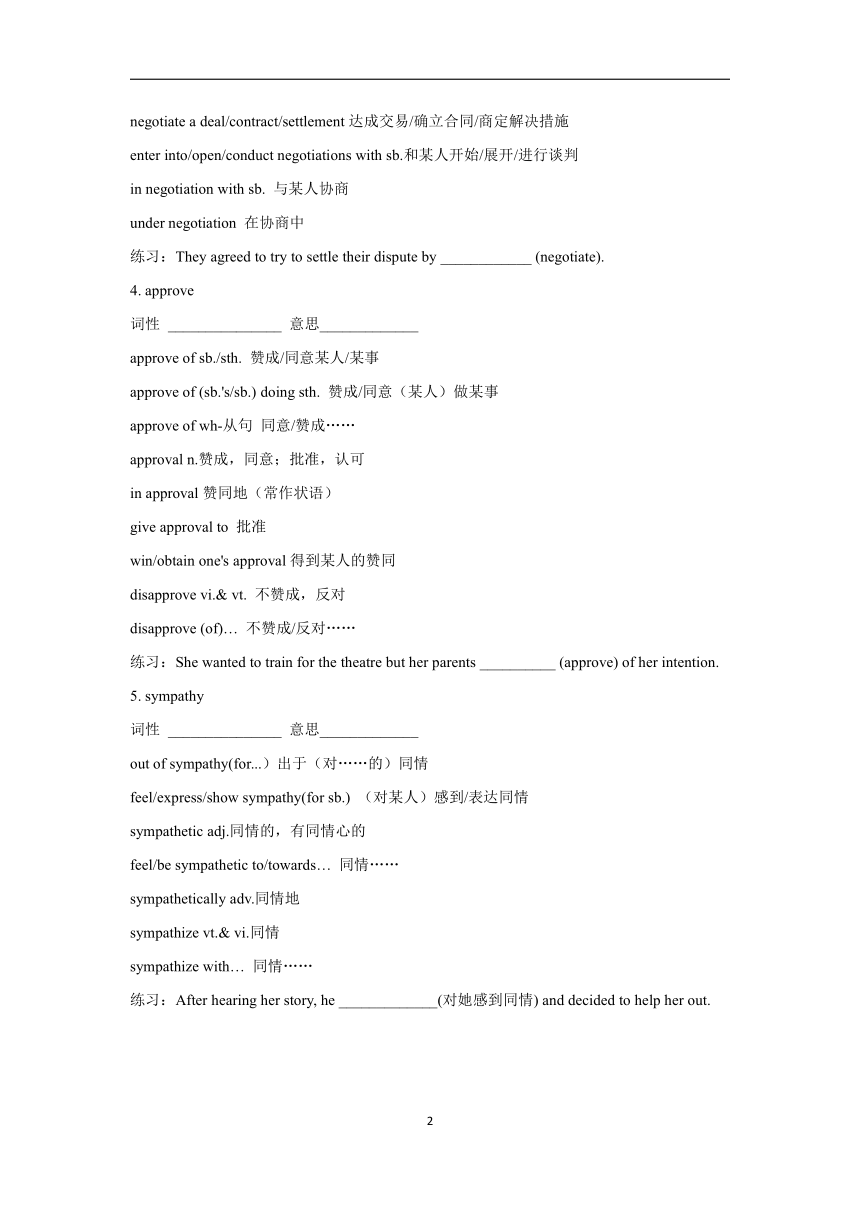牛津译林版(2019)选修四Unit 2 Understanding each other Section A Welcome to the unit & Reading学案(含答案)
文档属性
| 名称 | 牛津译林版(2019)选修四Unit 2 Understanding each other Section A Welcome to the unit & Reading学案(含答案) |  | |
| 格式 | doc | ||
| 文件大小 | 42.5KB | ||
| 资源类型 | 教案 | ||
| 版本资源 | 牛津译林版(2019) | ||
| 科目 | 英语 | ||
| 更新时间 | 2022-10-10 16:49:09 | ||
图片预览


文档简介
Section A Welcome to the unit & Reading
学习目标
1、学会本节单词、短语。
2、掌握本节句型表达与运用。
知识运用
1. react
词性 _______________ 意思_____________
react to sth. (by doing sth.) (通过做某事)对某事/物作出反应
react to... 对……过敏
react with sth.与某物发生化学反应
reaction n.反应、回应;化学反应(常与介词to连用)
练习:In the past, there was often an automatic ___________ (react) to increased traffic: just widen the roads.
2. suit
词性 _______________ 意思_____________
词性 _______________ 意思_____________
suit one's needs/tastes满足某人的需要/适合某人的口味
suit sth. to… 使某物适合……
suited adj.合适,适宜,适当(不用于名词前)
be suited for/to… 适宜……
suitable adj. 合适的,适宜的
unsuitable adj. 不合适的
be suitable for... 适合……
be unsuitable for... 不适合……
练习:People settle in these places because they are easy to get to and naturally suited ________ communications and trade.
3. negotiation
词性 _______________ 意思_____________
negotiate (with sb.) about/for sth. 就某事(和某人)谈判
negotiate a deal/contract/settlement达成交易/确立合同/商定解决措施
enter into/open/conduct negotiations with sb.和某人开始/展开/进行谈判
in negotiation with sb. 与某人协商
under negotiation 在协商中
练习:They agreed to try to settle their dispute by ____________ (negotiate).
4. approve
词性 _______________ 意思_____________
approve of sb./sth. 赞成/同意某人/某事
approve of (sb.'s/sb.) doing sth. 赞成/同意(某人)做某事
approve of wh-从句 同意/赞成……
approval n.赞成,同意;批准,认可
in approval赞同地(常作状语)
give approval to 批准
win/obtain one's approval得到某人的赞同
disapprove vi.& vt. 不赞成,反对
disapprove (of)… 不赞成/反对……
练习:She wanted to train for the theatre but her parents __________ (approve) of her intention.
5. sympathy
词性 _______________ 意思_____________
out of sympathy(for...)出于(对……的)同情
feel/express/show sympathy(for sb.) (对某人)感到/表达同情
sympathetic adj.同情的,有同情心的
feel/be sympathetic to/towards… 同情……
sympathetically adv.同情地
sympathize vt.& vi.同情
sympathize with… 同情……
练习:After hearing her story, he _____________(对她感到同情) and decided to help her out.
阅读探究
1. What is communication
2. What information can help you determine how best to communicate with others
3. Why should you pay attention to the other person's body language
4. How can you seek to understand the other person's emotions
句型梳理
They could be interpreted as a welcoming greeting from a close friend, especially if accompanied by a gentle smile. When spoken by a stranger, they can function as a means of attracting your attention.
它们可以被理解为密友表示欢迎的问候,尤其是伴以温柔微笑的时候;当出自陌生人之口时,它们起着引起注意的作用。
语法:状语从句的省略
状语从句的省略使行文更简洁、紧凑、有力、形象。一般来说,省略现象出现在下列五种状语从句中:
时间状语从句:when,while,as,before,after,till,until,once 等引导
条件状语从句:if,unless等引导
让步状语从句:though,although,even if,whatever 等引导
比较状语从句:as,than等引导
方式状语从句:as,as if,as though等引导
常见的状语从句的省略现象有以下几种结构:
(1)连接词+非谓语动词
该省略现象需具备两个基本条件:状语从句的主语与主句的主语一致,且从句谓语含有be动词的某种形式。至于用什么样的非谓语动词形式,需要考虑三个因素:
①动词与主语是逻辑上的主谓关系,用现在分词形式;
②动词与主语是逻辑上的动宾关系,用过去分词形式;
③表示动作将要发生,用动词不定式。
While (she was) walking along the river bank, Jane was singing a pop song.
简沿着河堤边走边唱着流行歌曲。
Unless (they were) asked to answer questions, the students were not allowed to talk in Prof. Li's class.
在李教授的课上,除非被要求回答问题,否则,学生是不允许说话的。
He stood up as if (he were) to say something.
他站起来好像要说什么。
(2)连接词+名词/形容词/介词短语
这种省略现象需具备两个条件:
①状语从句的主语与主句的主语一致;
②状语从句谓语中含有be动词的某种形式。
具备以上两个条件,可以省略状语从句的主语和be动词。
While (he was) a little boy, he was always ready to help others.
当他还是个小男孩时,他总是乐于助人。
Work hard when (you are) young, or you'll regret.
少壮不努力,老大徒伤悲。
When/While (I was) on my way to school, I met my English teacher.
在上学的路上,我遇见了我的英语老师。
(3)if型省略惯用语:
if necessary 如果有必要的话(if it is necessary 的省略形式)
if possible 如果有可能的话(if it is possible 的省略形式)
if so 如果这样的话
if not 如果不是
if any 如果有的话(表示“数量”意义)
if ever 如果有过/发生过的话(表示“频率”意义)
答案
知识运用
1. reaction 2. for/to 3. negotiation 4. disapproved 5. felt sympathetic for her
阅读探究
1. Communication is the exchange of information between a sender and a receiver.
2. You need to know with whom you are communicating. What is their age or job position What is their relationship to you What expectations and cultural background do they have
3. That's because it reveals a lot about the other person's thoughts and attitudes.
4. We can understand the other person's emotions by putting ourselves in their shoes and looking at the situation from their perspective.
2
学习目标
1、学会本节单词、短语。
2、掌握本节句型表达与运用。
知识运用
1. react
词性 _______________ 意思_____________
react to sth. (by doing sth.) (通过做某事)对某事/物作出反应
react to... 对……过敏
react with sth.与某物发生化学反应
reaction n.反应、回应;化学反应(常与介词to连用)
练习:In the past, there was often an automatic ___________ (react) to increased traffic: just widen the roads.
2. suit
词性 _______________ 意思_____________
词性 _______________ 意思_____________
suit one's needs/tastes满足某人的需要/适合某人的口味
suit sth. to… 使某物适合……
suited adj.合适,适宜,适当(不用于名词前)
be suited for/to… 适宜……
suitable adj. 合适的,适宜的
unsuitable adj. 不合适的
be suitable for... 适合……
be unsuitable for... 不适合……
练习:People settle in these places because they are easy to get to and naturally suited ________ communications and trade.
3. negotiation
词性 _______________ 意思_____________
negotiate (with sb.) about/for sth. 就某事(和某人)谈判
negotiate a deal/contract/settlement达成交易/确立合同/商定解决措施
enter into/open/conduct negotiations with sb.和某人开始/展开/进行谈判
in negotiation with sb. 与某人协商
under negotiation 在协商中
练习:They agreed to try to settle their dispute by ____________ (negotiate).
4. approve
词性 _______________ 意思_____________
approve of sb./sth. 赞成/同意某人/某事
approve of (sb.'s/sb.) doing sth. 赞成/同意(某人)做某事
approve of wh-从句 同意/赞成……
approval n.赞成,同意;批准,认可
in approval赞同地(常作状语)
give approval to 批准
win/obtain one's approval得到某人的赞同
disapprove vi.& vt. 不赞成,反对
disapprove (of)… 不赞成/反对……
练习:She wanted to train for the theatre but her parents __________ (approve) of her intention.
5. sympathy
词性 _______________ 意思_____________
out of sympathy(for...)出于(对……的)同情
feel/express/show sympathy(for sb.) (对某人)感到/表达同情
sympathetic adj.同情的,有同情心的
feel/be sympathetic to/towards… 同情……
sympathetically adv.同情地
sympathize vt.& vi.同情
sympathize with… 同情……
练习:After hearing her story, he _____________(对她感到同情) and decided to help her out.
阅读探究
1. What is communication
2. What information can help you determine how best to communicate with others
3. Why should you pay attention to the other person's body language
4. How can you seek to understand the other person's emotions
句型梳理
They could be interpreted as a welcoming greeting from a close friend, especially if accompanied by a gentle smile. When spoken by a stranger, they can function as a means of attracting your attention.
它们可以被理解为密友表示欢迎的问候,尤其是伴以温柔微笑的时候;当出自陌生人之口时,它们起着引起注意的作用。
语法:状语从句的省略
状语从句的省略使行文更简洁、紧凑、有力、形象。一般来说,省略现象出现在下列五种状语从句中:
时间状语从句:when,while,as,before,after,till,until,once 等引导
条件状语从句:if,unless等引导
让步状语从句:though,although,even if,whatever 等引导
比较状语从句:as,than等引导
方式状语从句:as,as if,as though等引导
常见的状语从句的省略现象有以下几种结构:
(1)连接词+非谓语动词
该省略现象需具备两个基本条件:状语从句的主语与主句的主语一致,且从句谓语含有be动词的某种形式。至于用什么样的非谓语动词形式,需要考虑三个因素:
①动词与主语是逻辑上的主谓关系,用现在分词形式;
②动词与主语是逻辑上的动宾关系,用过去分词形式;
③表示动作将要发生,用动词不定式。
While (she was) walking along the river bank, Jane was singing a pop song.
简沿着河堤边走边唱着流行歌曲。
Unless (they were) asked to answer questions, the students were not allowed to talk in Prof. Li's class.
在李教授的课上,除非被要求回答问题,否则,学生是不允许说话的。
He stood up as if (he were) to say something.
他站起来好像要说什么。
(2)连接词+名词/形容词/介词短语
这种省略现象需具备两个条件:
①状语从句的主语与主句的主语一致;
②状语从句谓语中含有be动词的某种形式。
具备以上两个条件,可以省略状语从句的主语和be动词。
While (he was) a little boy, he was always ready to help others.
当他还是个小男孩时,他总是乐于助人。
Work hard when (you are) young, or you'll regret.
少壮不努力,老大徒伤悲。
When/While (I was) on my way to school, I met my English teacher.
在上学的路上,我遇见了我的英语老师。
(3)if型省略惯用语:
if necessary 如果有必要的话(if it is necessary 的省略形式)
if possible 如果有可能的话(if it is possible 的省略形式)
if so 如果这样的话
if not 如果不是
if any 如果有的话(表示“数量”意义)
if ever 如果有过/发生过的话(表示“频率”意义)
答案
知识运用
1. reaction 2. for/to 3. negotiation 4. disapproved 5. felt sympathetic for her
阅读探究
1. Communication is the exchange of information between a sender and a receiver.
2. You need to know with whom you are communicating. What is their age or job position What is their relationship to you What expectations and cultural background do they have
3. That's because it reveals a lot about the other person's thoughts and attitudes.
4. We can understand the other person's emotions by putting ourselves in their shoes and looking at the situation from their perspective.
2
同课章节目录
